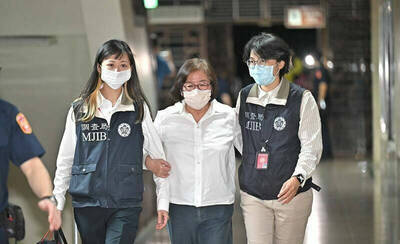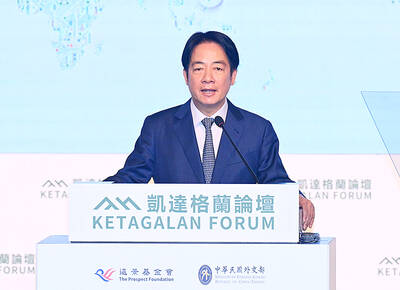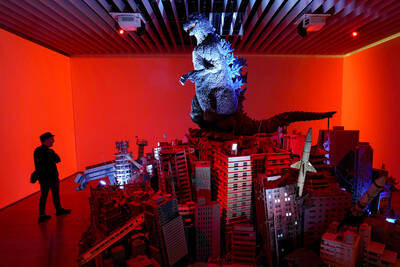Images of Parisian buildings and streets hover, falter, are superimposed on each other and multiply. Sometimes they spiral into an unrecognizable swirl; other times, they stutter at an almost imperceptible speed. Resurrection (甦醒), the solo exhibition by experimental filmmaker and academic Tony Chun-hui Wu (吳俊輝) currently on display at Galerie Grand Siecle (新苑藝術), is the artist’s latest attempt in his ongoing exploration of images in states of metamorphosis as they move through different formats and technologies.
Wu, an assistant professor at the department of radio, television and film in Shih Hsin University (世新大學), has shown his works shown at some of the world’s foremost art institutes, including the Museum of Modern Art in New York City, Centre Pompidou in Paris and San Francisco Cinematheque. His videos from before 2003 are generally made from collages and footage from 8mm and 16mm film and explore the aesthetic possibilities of various film formats. In 2005 he turned to digital filmmaking with Taipei 4-Way — exTAIPEIit (台北四非—遠離台北), which was exhibited at the Taipei Biennial at the Taipei Fine Arts Museum (台北市立美術館). His 2006 exhibition Europe Resurrection saw Wu expanding into multimedia with a study that combined still photography, film and digital imaging.
A natural progression from Europe Resurrection, Resurrection comprises four new filmic works building on color sides that Wu photographed last summer in Paris during his residency at the Cite Internationale des Arts. Still images are cut, split, reconstructed and reprinted on 35mm film, which is then digitally edited. The result is infinite combinations of images that seem almost desperate to return to the original medium in which they were captured, an impossible task as segments and details are lost and omitted in the process of conversion from format to format. “The stills are animated and transformed by the filmic time and then (re)frozen in digital imaging. But such freezing can only be possible in a state of ambiguity, as the images are engraved with the sense of time inherent in still photography and film,” Wu said.
Resurrection can be divided into two themes, according to content. Paris Resurrection shows 15 famous locations in Paris that disintegrate, fuse, accelerate and freeze in a visual experience that mimics the perspective of a traveler passing through the city.
But I Couldn’t See Her Face focuses on the perception created by shifting the relationship between the artist and the places he films. “Say I took one photo of the Notre Dame de Paris every 10 steps as I walked toward it. When translated into film, the architecture would appear to oscillate because the relation between us changed,” Wu explained.
Standing in contrast with the above two, Bonne Paris and Last Night, I Had a Dream About Our Mother are made from images of empty streets the artist took in Paris’ 20 arrondissements, or districts. The inspiration came from Wu’s perception of Paris in the summer as a ghost town haunted by ghostly tourists.
Hoping to show not only the end result but also the creative process, Wu will use the gallery as a studio from time to time, starting new projects in a dimly lit room at the end of the gallery. Visitors are welcome to sit with the artist and ask lots of questions.
Wu believes an artist should have the courage to challenge prevailing ideas. Recalling the raised eyebrows and general disapproval when Europe Resurrection was first staged, he noted that experimental cinema isn’t well received by the contemporary art scene in Taiwan, though the artistic form has long been part of the fine-arts tradition in the West. In Taiwan, he said, the Golden Harvest Awards (金穗獎) and Urban Nomad Film Festival are the only remaining venues that support experimental filmmaking.
“I see an incredible amount of creativity and energy in my students’ works, but there are no venues to show them,” Wu said. “I am planning to organize a showcase for experimental films with my students. It will begin with the campus, of course, but may grow into an international venue someday.”

Following the shock complete failure of all the recall votes against Chinese Nationalist Party (KMT) lawmakers on July 26, pan-blue supporters and the Chinese Communist Party (CCP) were giddy with victory. A notable exception was KMT Chairman Eric Chu (朱立倫), who knew better. At a press conference on July 29, he bowed deeply in gratitude to the voters and said the recalls were “not about which party won or lost, but were a great victory for the Taiwanese voters.” The entire recall process was a disaster for both the KMT and the Democratic Progressive Party (DPP). The only bright spot for

As last month dawned, the Democratic Progressive Party (DPP) was in a good position. The recall campaigns had strong momentum, polling showed many Chinese Nationalist Party (KMT) lawmakers at risk of recall and even the KMT was bracing for losing seats while facing a tsunami of voter fraud investigations. Polling pointed to some of the recalls being a lock for victory. Though in most districts the majority was against recalling their lawmaker, among voters “definitely” planning to vote, there were double-digit margins in favor of recall in at least five districts, with three districts near or above 20 percent in

From Godzilla’s fiery atomic breath to post-apocalyptic anime and harrowing depictions of radiation sickness, the influence of the nuclear bombings of Hiroshima and Nagasaki runs deep in Japanese popular culture. In the 80 years since the World War II attacks, stories of destruction and mutation have been fused with fears around natural disasters and, more recently, the Fukushima crisis. Classic manga and anime series Astro Boy is called “Mighty Atom” in Japanese, while city-leveling explosions loom large in other titles such as Akira, Neon Genesis Evangelion and Attack on Titan. “Living through tremendous pain” and overcoming trauma is a recurrent theme in Japan’s

The great number of islands that make up the Penghu archipelago make it a fascinating place to come back and explore again and again. On your next trip to Penghu, why not get off the beaten path and explore a lesser-traveled outlying island? Jibei Island (吉貝嶼) in Baisha Township (白沙鄉) is a popular destination for its long white sand beach and water activities. However, three other permanently inhabited islands in the township put a unique spin on the traditional Penghu charm, making them great destinations for the curious tourist: Yuanbeiyu (員貝嶼), Niaoyu (鳥嶼) and Dacangyu (大倉嶼). YUANBEIYU Citou Wharf (岐頭碼頭) connects the mainland